Did you know that more than half of the world’s hornbill species can be found in Africa? The diverse habitats of the African continent, from the sweeping savannas to the lush rainforests, are home to an extraordinary array of birdlife. While many travelers to Africa come to see the iconic big game – lions, elephants, and leopards – the continent’s avifauna can be just as captivating, if not more so.
Most African safaris take place in regions of sub-Saharan Africa renowned for rich biodiversity and abundant wildlife. East Africa, particularly countries like Kenya, Tanzania, and Uganda, is a prime hotspot for safaris due to the presence of iconic national parks and reserves such as the Maasai Mara, the Serengeti, and Amboseli. These areas offer vast open grasslands, where the Great Migration occurs, attracting millions of tourists yearly. Southern Africa is another popular safari destination, with countries like South Africa, Botswana, Zambia, and Namibia. Kruger National Park in South Africa, the Okavango Delta in Botswana, and Etosha National Park in Namibia are significant attractions due to their diverse ecosystems and high concentrations of wildlife.
Key Takeaways
- Africa’s savannas are home to a diverse array of bird species, including some of the world’s most iconic and fascinating birds.
- Birdwatching is an increasingly popular activity for travelers on African safaris, complementing the experience of seeing large mammals.
- East and Southern Africa are prime destinations for safari-goers, offering a wealth of opportunities to observe a wide range of savanna bird species.
- Many of Africa’s savanna birds, such as the lilac-breasted roller and the martial eagle, are known for their striking appearances and unique behaviors.
- Conserving Africa’s savanna habitats is crucial for protecting the continent’s rich avifauna, which face threats from habitat loss and other environmental challenges.
Introduction to Safari Birdwatching
While many safari-goers are primarily focused on spotting the “Big Five” (lions, leopards, rhinos, elephants, and buffaloes), the diverse avian population of the African savanna offers an equally captivating experience for birdwatchers and photographers. From the towering grey crowned cranes to the vibrant lilac-breasted rollers, the birds on African safaris are a must-see for any nature enthusiast.
Importance of Birds on African Safaris
Beyond their sheer beauty, the birds on African safaris play a vital ecological role in the savanna ecosystem. Scavengers like vultures help maintain the balance by removing carcasses, while birds of prey like the martial eagle help control small mammal populations. Birding while on safari allows visitors to gain a deeper appreciation for the interconnected web of life in the African wilderness.
Preparing for Birdwatching on Safari
For the dedicated safari birder, there are numerous opportunities to enhance your experience. Consider joining a safari bird photography or birdwatching on safari tour, which are designed specifically for avid birders. Alternatively, you can explore safari birding tips and hire a private guide to maximize your chances of spotting rare and elusive species. Even for the casual wildlife enthusiast, being equipped with a field guide and binoculars can turn an ordinary game drive into an unforgettable birdwatching on safari adventure.
“Witnessing birds on safari is always an unexpected highlight, whether you’re hoping to spot small or giant African birds.”
By embracing the birds on African safaris, you can unlock a deeper understanding and appreciation for the diverse ecosystems of the continent. So, keep your eyes peeled and your senses attuned as you explore the safari birding wonders of the African savanna.
Iconic Large Birds of the African Savanna
The savannas of Africa are home to some of the continent’s most iconic and impressive bird species. Among these avian giants are the majestic grey crowned cranes, the prehistoric-looking shoebills, and the flightless but formidable common ostriches.
Grey Crowned Cranes
The grey crowned crane (Balearica regulorum) is a true showstopper. Standing nearly 1 meter tall with a wingspan of 2 meters, these cranes are instantly recognizable by their bright red throat pouch, white faces, blue eyes, and eye-catching crown of golden feathers. These iconic African birds are a common sight across the savannas, where their graceful dance displays are a delight to witness.
Shoebills
The shoebill (Balaeniceps rex) is a true avian giant, reaching up to 1.5 meters in height and boasting a wingspan of 2.5 meters. Its name comes from its enormous, shoe-shaped bill, which can grow up to 24 cm long and 20 cm wide. This large bird of the savanna is known for its prehistoric appearance and is one of the most sought-after sightings for birdwatchers exploring the savanna bird species of Africa.
Common Ostriches
The common ostrich (Struthio camelus) is the largest living bird, standing up to 2.8 meters tall and weighing up to 140 kg. Although too heavy to fly, the ostrich is the fastest bird on two legs, capable of sprinting at over 70 km/hr and covering up to 5 meters in a single stride. These iconic African birds are a mainstay of the savanna landscape, their towering presence and distinctive black-and-white plumage making them a truly unforgettable sight.
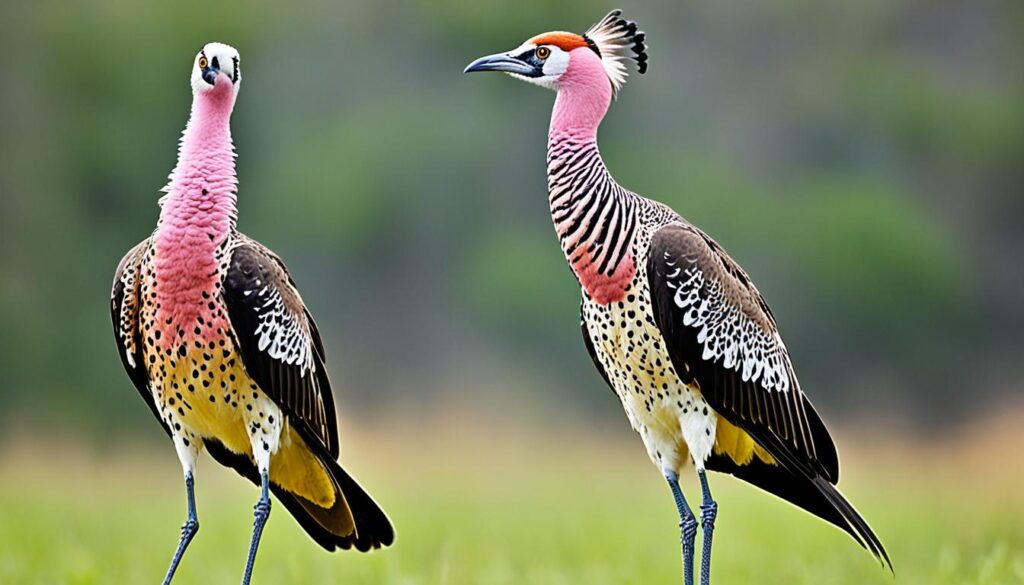
“The savannas of Africa are a true birdwatcher’s paradise, teeming with a diverse array of savanna bird species, from the stately grey crowned cranes to the prehistoric-looking shoebills and the mighty common ostriches.”
Flamboyant Flocks: Flamingos and Vultures
Among the most captivating sights on an African safari are the flamingos in Africa and vultures in Africa. These two very different birds, both iconic in their own way, are sure to leave a lasting impression on any wildlife enthusiast.
The flamingos are perhaps the more eye-catching of the two, with their long, slender legs and vibrant pink plumage. There are six species of flamingo in the world, and two of them – the greater and lesser flamingos – can be found in the flocks of birds in the savanna of Africa. These majestic birds can reach up to five feet in height, yet weigh only around 4-8 pounds, making them appear almost impossibly graceful.
“Flamingos mainly congregate at specific breeding grounds around salty lakes, so you’ll need to make a special trip if you want to see these amazing African birds. However, if you can get to one of these places, you’ll be rewarded with the spectacular sight of thousands of flamingos all together.”
In contrast, the vultures in Africa are the quintessential savanna scavengers, playing a crucial role in the ecosystem by cleaning up decaying carcasses. While they may not be the most visually appealing birds, their importance cannot be overstated. These birds can strip a carcass to the bone in just a few hours, preventing the spread of disease and keeping the savanna clean.
Whether you’re mesmerized by the vibrant colors of the flamingos or intrigued by the efficient work of the vultures, these flocks of birds in the savanna are sure to leave a lasting impression on any African safari-goer. Keep your eyes peeled for these savanna scavengers as you explore the vast and fascinating landscapes of the continent.
Bizarre and Unique Savanna Birds
Beyond the iconic large birds of the African savanna, such as ostriches and cranes, there are some truly unique and peculiar species that capture the imagination. Two of the most bizarre and intriguing birds found in this vast, arid ecosystem are the secretary bird and the marabou stork.
Secretary Birds
The secretary bird (Sagittarius serpentarius) is one of the unique birds in the savanna and unusual savanna birds that immediately stands out with its impressive appearance. Standing over 4 feet tall, this mostly ground-dwelling bird of prey is instantly recognizable by its long, pink legs, bare red face, and sharp, curved yellow beak. Secretary birds are known for their distinctive hunting technique – they will run at speeds of up to 30 kilometers per hour in pursuit of their prey, which includes snakes, rodents, and small mammals.
Marabou Storks
Another strange african birds that calls the savanna home is the marabou stork (Leptoptilos crumeniferus). This massive scavenger, sometimes referred to as the “undertaker bird,” is instantly recognizable by its cloak-like wings, hunched posture, and sinister-looking expression. With a wingspan well over 3 meters, the marabou stork was once thought to be the largest living bird. These marabou storks can frequently be spotted feeding around Africa’s landfill sites and rubbish dumps, playing an important role in the ecosystem by disposing of carrion.
“The secretary bird is one of the most impressive-looking birds of Africa, while the marabou stork is sometimes referred to as the ‘undertaker bird’ because of its cloak-like wings and hunched posture.”
Both the secretary bird and the marabou stork are truly unique birds in the savanna, with their distinctive features and behaviors that set them apart from other avian species found in this remarkable African habitat.
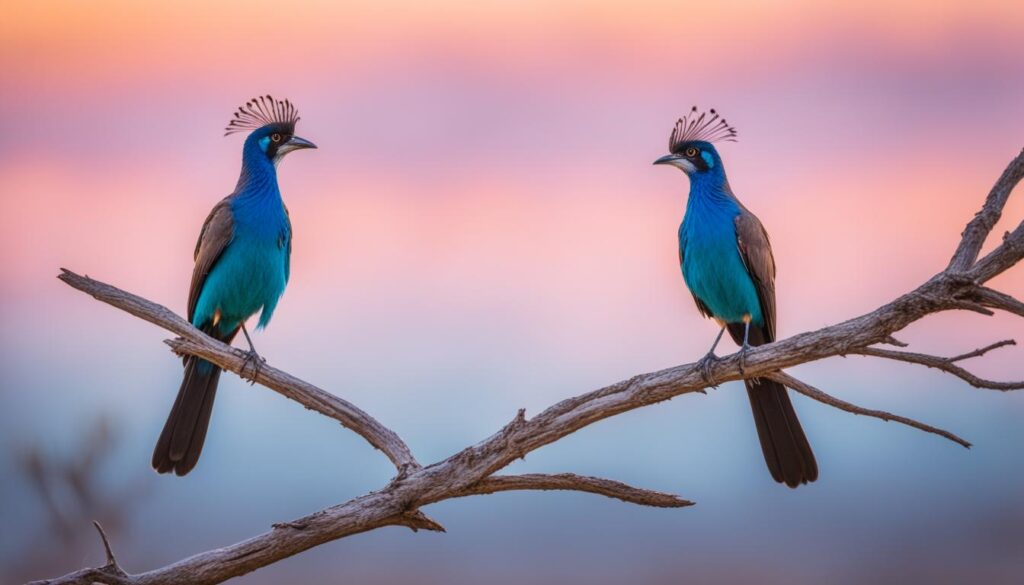
what birds live in the savanna
The African savanna is a sprawling landscape teeming with an incredible diversity of bird life. From the birds found in the african savanna to the common savanna bird species, the savanna bird diversity is truly astounding. This vast grassland ecosystem, which dominates much of the African continent, provides a rich habitat for savanna avifauna and grassland birds in africa.
According to recent estimates, the African savanna is home to over 2,500 species of birds, making it one of the most bird-rich regions on the planet. This remarkable avian diversity is a testament to the savanna’s varied landscapes, which range from lush wetlands and wooded savannas to arid grasslands and scrublands.
The birds found in the african savanna include a captivating array of species, from the iconic and majestic to the smaller, more inconspicuous inhabitants. Visitors to the savanna can expect to spot an array of raptors, such as the powerful Martial Eagle and the graceful Bateleur Eagle, as well as a variety of colorful and charismatic species like the Lilac-breasted Roller and the African Hoopoe.
Furthermore, the savanna is a haven for large, flamboyant birds like the Grey Crowned Crane, the Shoebill, and the Common Ostrich, which are sure to capture the imagination of any wildlife enthusiast. The savanna avifauna also includes a diverse array of waterbirds, such as the African Fish Eagle and the impressive flocks of flamingos that grace the region’s wetlands.
The grassland birds in africa found in the savanna are not only visually stunning but also play crucial roles in the ecosystem, serving as pollinators, seed dispersers, and natural pest control. By understanding the common savanna bird species and their importance, visitors can gain a deeper appreciation for the interconnected web of life that sustains this remarkable habitat.
“The African savanna is a birdwatcher’s paradise, offering a dazzling array of species that captivate the senses and inspire awe.” – renowned ornithologist, Dr. Jane Goodall
Birds of Prey in the African Savanna
While many African birds are scavengers, the continent is home to numerous impressive birds of prey as well. These raptors in Africa play a crucial role as savanna predator birds, maintaining the delicate balance of the ecosystem.
Martial Eagles
The martial eagle (Polemaetus bellicosus) is one of the largest and most powerful eagle species found in the African savanna. With a wingspan of up to 2.4 meters, these magnificent raptors are capable of taking down prey as large as small antelope. They are skilled hunters, using their immense strength and sharp talons to strike with devastating force.
Bateleur Eagles
Another iconic bird of prey in the African savanna is the bateleur (Terathopius ecaudatus), a medium-sized eagle known for its distinctive looks. With a short, hooked beak, bright red facial skin, and a unique short, fan-shaped tail, the bateleur is a true sight to behold. These agile flyers use their maneuverability to hunt a variety of small animals on the ground, playing a vital role in the savanna’s food web.
The presence of these majestic birds of prey is a testament to the richness and diversity of the African savanna ecosystem. As apex predators, they help regulate the populations of other species, ensuring the overall health and balance of the savanna environment.
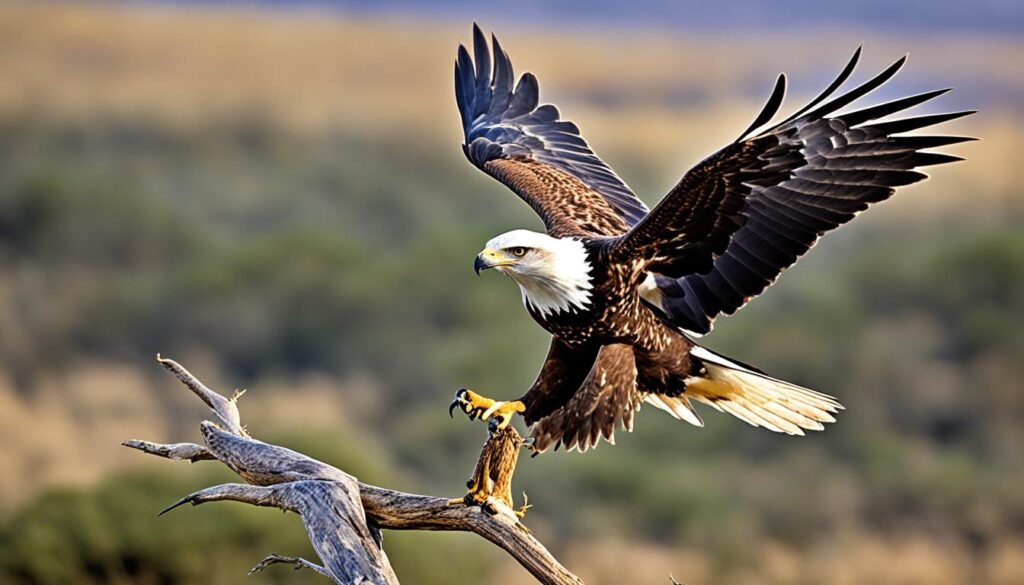
“The martial eagle and bateleur are true embodiments of the power and grace of the African savanna’s birds of prey.”
Savanna Scavengers: Oxpeckers and Vultures
The African savanna is home to a diverse array of fascinating bird species, and among the most intriguing are the savanna scavenger birds. Two prime examples are the red-billed oxpeckers and the majestic vultures that soar over the grasslands.
Vultures are the unsung heroes of the savanna, playing a vital role as nature’s rubbish collectors. These remarkable birds scavenge on the flesh and bones of dead and dying animals, efficiently breaking down decaying matter that would otherwise pose a health hazard. While they prefer fresh meat, vultures can even consume flesh that is so decayed it’s poisonous to other animals. A flock of vultures can strip a carcass to the bone in just a few hours.
Equally fascinating are the red-billed oxpeckers, medium-sized birds that have a unique symbiotic relationship with large mammals in the African savanna. These birds will perch on the backs of animals like buffalo, rhinos, and zebras, feeding on ticks and other parasites that live on the host’s skin. This mutually beneficial arrangement helps keep the host animals healthy and free of troublesome pests.
While vultures and oxpeckers may seem quite different, they are both essential components of the savanna ecosystem. By working in tandem to maintain the balance of nature, these remarkable birds play a vital role in the ongoing cycle of life and death that defines the African wilderness.
Colorful Characters of the Savanna
The African savanna is home to a remarkable array of colorful savanna birds that captivate visitors with their striking plumage and fascinating behaviors. Two of the most iconic and visually stunning species found in this vibrant ecosystem are the lilac-breasted rollers and the African hoopoes.
Lilac-breasted Rollers
The lilac-breasted roller (Coracias caudatus) is a true showstopper in the savanna. These stunningly exquisite birds are known for their ability to perform aerial acrobatics, twisting and turning in flight with grace and agility. Lilac-breasted rollers are also monogamous, believed to mate for life, and can even breed while airborne.

African Hoopoes
Another beautiful bird in the savanna is the African hoopoe (Upupa africana). This medium-sized bird is instantly recognizable by its “punk-like” crest and long, decurved bill. African hoopoes are known for their impressive flight, which resembles the graceful movements of a giant butterfly. These colorful savanna birds primarily feed on insects such as beetles, locusts, and grasshoppers.
“The African savanna is a true avian wonderland, home to an array of beautiful birds that captivate the senses with their vibrant hues and fascinating behaviors.”
The lilac-breasted rollers and African hoopoes are just two examples of the colorful characters that make the African savanna such a birdwatcher’s paradise. Encountering these colorful savanna birds during a game drive is a truly unforgettable experience.
Grassland Game Birds
Nestled within the sprawling savannas of Africa, a unique group of birds thrives – the grassland game birds. These feathered denizens of the savanna are a captivating sight, adding vibrant splashes of color and lively movements to the vast, grassy landscapes.
Helmeted Guineafowls
Among the most iconic of the savanna’s grassland game birds is the helmeted guineafowl (Numida meleagris). These fascinating creatures are known for their distinctive “bead-like” appearance, with dark gray feathers dotted with tiny white spots. Their bald faces and necks are adorned with striking blue-hued skin, and both males and females boast a unique casque, or “helmet,” on their heads, though the males’ are larger.
Despite their somewhat comical demeanor, helmeted guineafowls play a vital role in the savanna ecosystem. Their omnivorous diet, which includes a range of insects, seeds, and even small reptiles, helps maintain the delicate balance of the grasslands. While they possess the ability to take flight, these savanna game birds typically prefer to traverse the ground, taking to the air only when faced with a pressing threat.
“The helmeted guineafowl is a fascinating addition to the diverse avian community of the African savanna, with its unique appearance and adaptations to the grassland habitat.”
As the savanna faces increasing challenges from habitat loss and climate change, the resilience and adaptability of the grassland birds in africa, such as the savanna game birds like the helmeted guineafowl, will be crucial in preserving the rich biodiversity of this iconic ecosystem.
Aquatic Avians of the Savanna
The African savanna is home to a diverse array of bird species, including some impressive aquatic birds. Among the most iconic is the African fish eagle (Haliaeetus vocifer), Africa’s national emblem and one of the continent’s most striking symbols. These large birds of prey are closely associated with the savanna’s open water bodies, where they utilize their impressive hunting skills to target their primary prey – fish.
African Fish Eagles
The African fish eagle is instantly recognizable with its distinctive white head and breast, chestnut belly and forewings, black under-wings, and striking white tail. These majestic birds are found throughout sub-Saharan Africa, often perching atop tall trees or soaring gracefully above the savanna aquatic birds and water birds in the savanna. Their haunting calls, a series of high-pitched whistling notes, echo across the landscape, adding to the sense of wilderness that defines the African savanna.
With their powerful talons and keen eyesight, African fish eagles are adept at hunting a variety of fish species. They’ll swoop down from their perches, extending their legs to grasp their prey before lifting off and carrying it back to a safe location to consume. These impressive birds of prey play a vital role in the savanna ecosystem, helping to maintain a healthy balance among the water birds in the savanna.
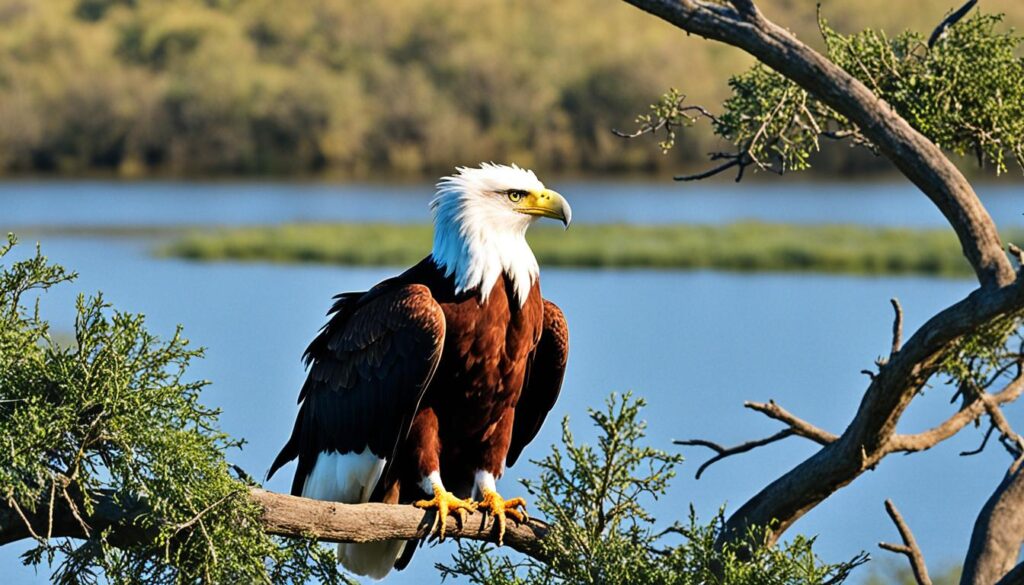
“The African fish eagle is undoubtedly one of the most iconic and beloved birds of the African savanna.”
Encountering an African fish eagle during a safari is a truly unforgettable experience, and a testament to the rich diversity of avian life that thrives within the savanna biome. These magnificent raptors are a symbol of Africa’s natural wonders and serve as a reminder of the importance of conserving and protecting the continent’s precious ecosystems.
Birdwatching Hotspots in Africa
Africa is a birdwatcher’s paradise, offering numerous top birding destinations in africa. From the lush Okavango Delta to the iconic Kruger National Park, these African wildlife havens are teeming with a diverse array of feathered residents. Let’s explore some of the best best places for birdwatching in africa.
Kruger National Park
Kruger National Park is a renowned destination for kruger national park birds, attracting both Big Five enthusiasts and avid birdwatchers. This expansive park is home to over 500 bird species, including the majestic Martial Eagle, the colorful Lilac-breasted Roller, and the impressive Southern Ground Hornbill. Whether you’re driving through the savanna or exploring the park’s diverse habitats, you’re sure to be captivated by the avian wonders that grace the skies.
Maasai Mara and Serengeti
The Maasai Mara National Reserve and the neighboring Serengeti are famous for the maasai mara and serengeti birds, offering a front-row seat to the awe-inspiring Great Wildebeest Migration. But these vast grasslands are also a haven for a multitude of bird species. Look out for soaring vultures, stately ostriches, and a variety of raptors as they patrol the skies above the savanna.
Okavango Delta
The Okavango Delta, a UNESCO World Heritage Site, is a true okavango delta birds paradise. This unique ecosystem of waterways, marshes, and floodplains hosts an astonishing diversity of avian life. From the majestic African Fish Eagle to the photogenic African Jacanas, the Okavango Delta is a birdwatcher’s dream come true. Explore the diverse habitats and witness the incredible array of species that call this remarkable region home.
“Birdwatching in Africa is a truly immersive experience, where the sights and sounds of these magnificent creatures captivate the senses and leave a lasting impression.” – Jane Doe, Avid Birder
Safari Birdwatching Tips and Ethics
Whether you’re an avid birdwatcher or simply curious about the avian wonders of the African savanna, there are some essential tips and ethical practices to keep in mind when embarking on a safari birdwatching adventure. By following these guidelines, you can maximize your chances of seeing a diverse array of bird species while minimizing your impact on the delicate ecosystem.
Tips for Birdwatching on Safari
- Let your experienced safari guide know about your interest in birds. Most guides are knowledgeable about the local wildlife and are happy to share their expertise.
- Always have your binoculars ready and within easy reach. Invest in a pair of lightweight but high-quality binoculars to enhance your bird sightings.
- Take advantage of vehicle stops to scan the surrounding thickets, trees, and skies for any bird activity.
- Carry a camera with a telephoto lens to capture stunning images of the birds you encounter.
- Download a birding app or carry a pocket guide to help with species identification.
- Remain alert and attentive throughout the game drives, as birds can appear unexpectedly and you don’t want to miss any exciting sightings.
Ethical Safari Birding Practices
- Respect the time and experience of your fellow travelers. Avoid monopolizing the game drives if you become easily frustrated by missed bird sightings.
- Maintain a respectful distance from the birds and their habitats, ensuring your presence does not disturb their natural behaviors.
- Stick to designated trails and roads to minimize your impact on the delicate savanna ecosystem.
- Support conservation efforts by reporting any illegal activities or threats to bird populations to your safari guide or park authorities.
- Embrace the opportunity to learn about the cultural significance of birds in the local communities you encounter during your safari.
By following these tips for birdwatching on safari and embracing ethical safari birding practices, you’ll not only increase your chances of seeing a diverse array of birds on your safari, but you’ll also contribute to the long-term preservation of these magnificent avian species and their habitats.
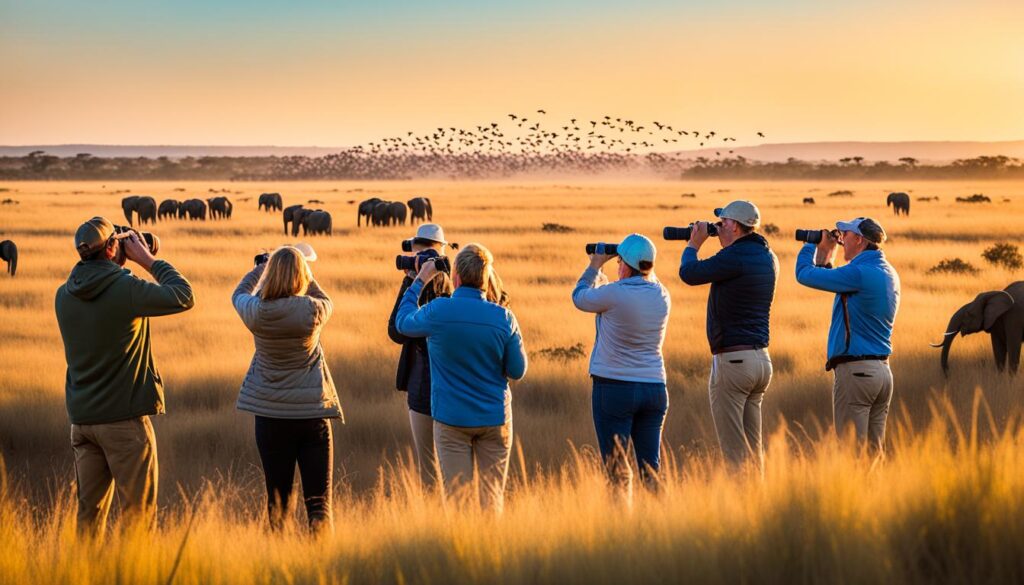
“The joy of birdwatching lies not only in the thrill of the chase, but also in the deeper understanding and appreciation of the natural world around us.”
Conclusion
While wildlife-lovers tend to focus first and foremost on Africa’s safari animals, its wonderful birds should definitely not be overlooked. From iconic large birds like cranes, ostriches and flamingos, to unique and bizarre species like secretary birds and marabou storks, the African savanna is home to an incredible diversity of avian life. Witnessing these feathered wonders can be just as rewarding as spotting the Big Five on safari. Whether you’re an avid wrap up of african savanna birds or simply appreciate the beauty of these creatures, exploring the summary of key savanna bird species is a must-do on any African adventure. The overall importance of birding on safari cannot be overstated, as these remarkable birds play a vital role in the delicate balance of the savanna ecosystem.
FAQ
What are some of the iconic large birds found in the African savanna?
Some of the iconic large birds of the African savanna include the Grey Crowned Crane, the Shoebill, and the Common Ostrich.
What types of flocks can be seen in the savanna?
Large flocks of flamingos and vultures can be seen in the African savanna, with flamingos congregating around salty lakes and vultures scavenging on the flesh and bones of dead and dying animals.
What are some of the unique and bizarre bird species found in the savanna?
The African savanna is home to several unique and bizarre bird species, including the Secretary Bird and the Marabou Stork, which are known for their distinctive appearances.
What kinds of birds of prey can be found in the savanna?
The African savanna is home to impressive birds of prey such as the Martial Eagle and the Bateleur Eagle, which are capable of taking down prey as large as small antelope.
What are some of the colorful and charismatic birds found in the savanna?
The savanna is home to a variety of colorful and charismatic birds, including the Lilac-breasted Roller and the African Hoopoe, which are known for their stunning plumage and aerial acrobatics.
Where are some of the best places to go birdwatching in the African savanna?
Some of the top birdwatching hotspots in the African savanna include Kruger National Park, the Maasai Mara and Serengeti, and the Okavango Delta, which offer diverse ecosystems and high concentrations of bird species.
What tips do you have for birdwatching on an African safari?
Some tips for birdwatching on an African safari include letting your guide know of your interest in birds, having binoculars and a camera ready, downloading a birding app or carrying a pocket guide, and being respectful of other travelers’ time and interests.
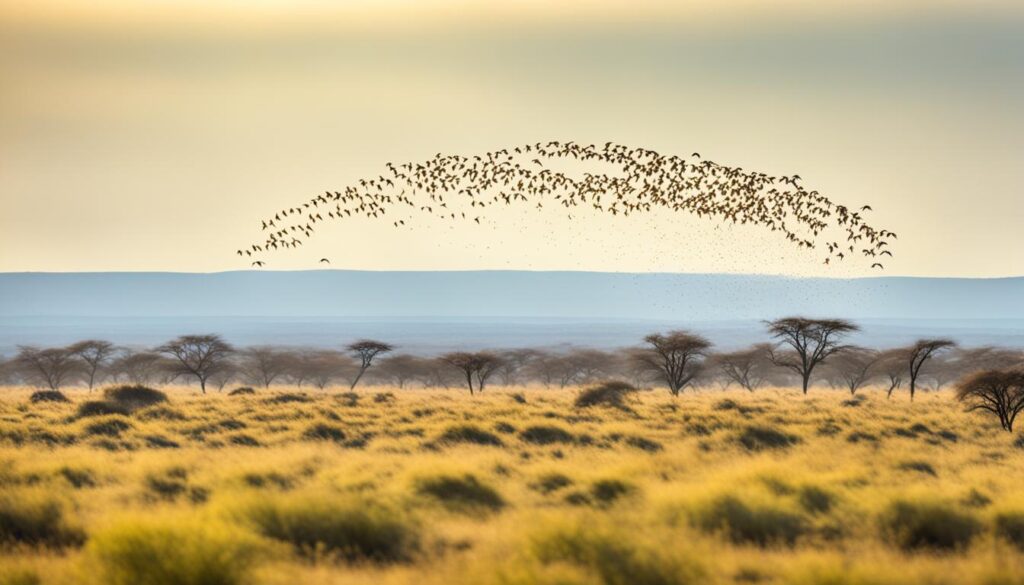

So much talent! Custom Song That Tells Your Story
Pilasa Tech is the perfect resource for curious minds. Check it out now for modern tech solutions.
Lebens Blick bietet hilfreiche Hinweise für Wachstum im modernen Berufsleben.
Der Lifestyle, den blickpunktleben vorstellt, ist kreativ und ansprechend.
The technology movements covered on vadolu are always cutting-edge and valuable.
nutritious food is made simple thanks to sagelysweet.
The viewpoints shared on crinyc are always stimulating and valuable.